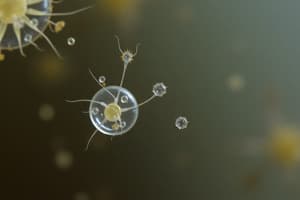Podcast
Questions and Answers
Which organism is responsible for causing malaria?
Which organism is responsible for causing malaria?
- *Aspergillus fumigatus*
- *Plasmodium spp.* (correct)
- *Candida albicans*
- *Entamoeba histolytica*
What is a common mode of transmission for helminths?
What is a common mode of transmission for helminths?
- Direct skin contact
- Inhalation of spores
- Transmission through contaminated air
- Ingestion of eggs or larvae (correct)
Which of the following is NOT a mechanism used by eukaryotic pathogens to cause disease?
Which of the following is NOT a mechanism used by eukaryotic pathogens to cause disease?
- Production of toxins
- Adherence to host cells
- Photosynthesis (correct)
- Evasion of immune response
What type of pathogen is Fusarium spp. classified as?
What type of pathogen is Fusarium spp. classified as?
What are common symptoms of protozoal infections?
What are common symptoms of protozoal infections?
Which diagnostic method is specifically used for detecting genetic material of pathogens?
Which diagnostic method is specifically used for detecting genetic material of pathogens?
Which treatment is appropriate for fungal infections?
Which treatment is appropriate for fungal infections?
What is a common symptom of systemic fungal infections?
What is a common symptom of systemic fungal infections?
Which type of pathogen is typically unicellular?
Which type of pathogen is typically unicellular?
Which of the following is a strategy used by pathogens to evade the immune response?
Which of the following is a strategy used by pathogens to evade the immune response?
Flashcards are hidden until you start studying
Study Notes
Eukaryotic Pathogens Overview
- Eukaryotic pathogens are organisms with complex cells that can cause disease in humans, animals, or plants.
- These pathogens include protozoa, fungi, helminths (worms), and some algae.
Types of Eukaryotic Pathogens
-
Protozoa
- Unicellular organisms.
- Examples:
- Plasmodium spp. (causes malaria)
- Entamoeba histolytica (causes amoebic dysentery)
- Transmission often through vectors (e.g., mosquitoes) or contaminated food/water.
-
Fungi
- Can be unicellular (yeasts) or multicellular (molds).
- Examples:
- Candida albicans (causes candidiasis)
- Aspergillus fumigatus (causes aspergillosis)
- Entry through inhalation, skin contact, or nosocomial infections.
-
Helminths
- Multicellular, often parasitic worms.
- Types:
- Nematodes (roundworms)
- Cestodes (tapeworms)
- Trematodes (flukes)
- Transmission typically via ingestion of eggs or larvae in contaminated food or water, or through skin penetration.
-
Algae (Pathogenic forms)
- Some can release toxins causing harm to humans or animals.
- Example:
- Fusarium spp. (mycotoxins)
- Generally not infectious but can cause harmful algal blooms affecting water supplies.
Pathogenic Mechanisms
- Adherence to host cells.
- Invasion of host tissue.
- Evasion of the immune response through various strategies (e.g., antigenic variation).
- Production of toxins or enzymes that damage host cells.
Disease Manifestations
- Symptoms vary widely depending on the pathogen and the site of infection.
- Common symptoms include:
- Diarrhea (often caused by protozoa and helminths)
- Fungal skin infections (e.g., athlete's foot)
- Systemic infections (e.g., fungal meningitis)
Diagnostic Methods
- Microscopy (e.g., examining stool samples for protozoa).
- Culture techniques (growing fungi or bacteria).
- Molecular methods (PCR for detecting genetic material).
- Serology (detecting antibodies in the host).
Treatment Strategies
- Protozoal infections may require antiprotozoal medications (e.g., chloroquine for malaria).
- Fungal infections may be treated with antifungal agents (e.g., fluconazole).
- Helminths often require anthelmintic drugs (e.g., albendazole).
- Prevention strategies include sanitation, hygiene, and vector control.
Eukaryotic Pathogens
- Eukaryotic pathogens are diverse and include protozoa, fungi, helminths (worms), and some algae.
- They are responsible for diseases in humans, animals, and plants.
Protozoa
- Unicellular organisms with diverse modes of transmission, often via vectors or contaminated sources.
- Examples include Plasmodium spp. (malaria) and Entamoeba histolytica (amoebic dysentery).
Fungi
- Can be yeasts (unicellular) or molds (multicellular).
- Common examples include Candida albicans (candidiasis) and Aspergillus fumigatus (aspergillosis).
- Entry points include inhalation, skin contact, and nosocomial infections.
Helminths
- Multicellular parasitic worms categorized into nematodes (roundworms), cestodes (tapeworms), and trematodes (flukes).
- Transmission typically involves ingestion of eggs or larvae in contaminated food/water or skin penetration.
Pathogenic Algae
- Some algae produce toxins that can harm humans and animals.
- Fusarium spp. is an example of algae that produces mycotoxins.
- Harmful algal blooms can affect water supplies and ecosystems.
Pathogenic Mechanisms
- Eukaryotic pathogens employ various mechanisms to cause disease, including:
- Adherence to host cells
- Invasion of host tissues
- Evasion of the immune response through strategies like antigenic variation
- Production of toxins or enzymes that damage host cells
Disease Manifestations
- Symptoms vary widely depending on the pathogen and site of infection.
- Common symptoms include diarrhea (protozoa, helminths), fungal skin infections, and systemic infections (e.g., fungal meningitis).
Diagnostic Methods
- Common methods include microscopy, culture techniques, molecular methods (PCR), and serology.
Treatment Strategies
- Treatment often involves specific medications tailored to the pathogen, such as:
- Antiprotozoal drugs for protozoal infections (e.g., chloroquine for malaria)
- Antifungal agents for fungal infections (e.g., fluconazole)
- Anthelmintic drugs for helminths (e.g., albendazole)
- Prevention strategies emphasize sanitation, hygiene, and vector control.
Studying That Suits You
Use AI to generate personalized quizzes and flashcards to suit your learning preferences.




